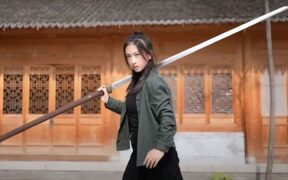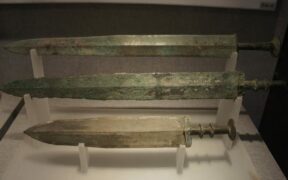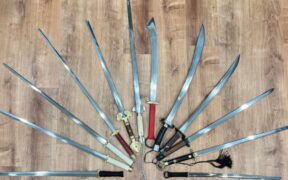Our content features commercial links to our products, committed to transparent, unbiased, and informed editorial recommendations. Learn More
Chinese Jian Swords: From Ancient Battlegrounds to Modern Dojos
NO AI USED This Article has been written and edited by our team with no help of the AI
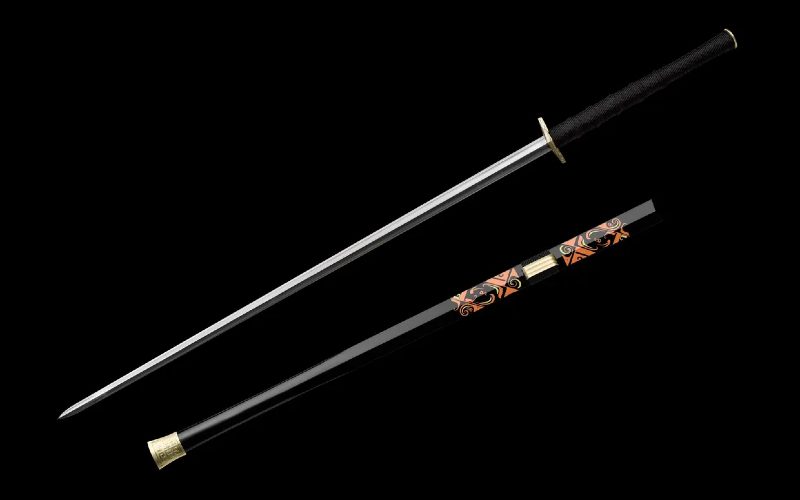
Jian, the double-edged sword, is the most common weapon in traditional Chinese martial arts. Historically, it served as a weapon for warfare and a symbol of moral values. Today, any double-edged Chinese sword is called a jian, but there are specific types you may need to be familiar with if you are into sword collecting.
Let’s explore the history of the jian sword, its significance to Chinese culture, unique characteristics, and use in martial arts.
Types of Jian Sword
The defining feature of the Chinese jian sword is that it has a straight, double-edged blade. Whether it is a long or short sword, it is called a jian. Here are some collector’s jargon to be familiar with:
Duan Jian (Short Sword )
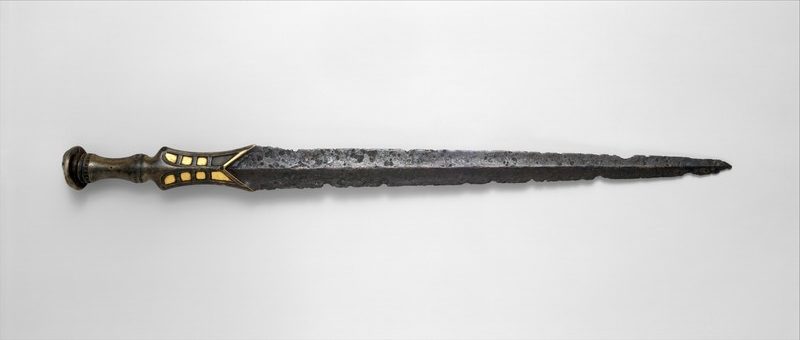
As the name suggests, the duan jian is a short jian sword, usually with an exotic appearance. Some featured longevity symbols and stylized creatures such as bats, monsters, salamanders, and dragons. Their overall length can be around 50 centimeters (19.7 inches), with their blades less than 40 centimeters (15.7 inches) long, which can usually fit in the steamer trunks.
Chang Jian (Long Sword )
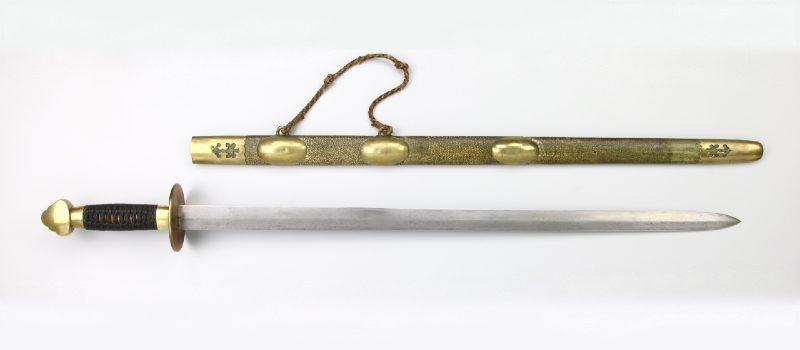
The chang jian refers to a long sword, with an overall length of more than 100 centimeters (39.4 inches) and a blade around 80 centimeters (31.5 inches) long. Most of them functioned as training swords for martial arts and had unsharpened steel blades. Still, there are rare examples of battle-ready chang jian with folded steel and differentially hardened blades.
Shuang Jian (Double Jian)
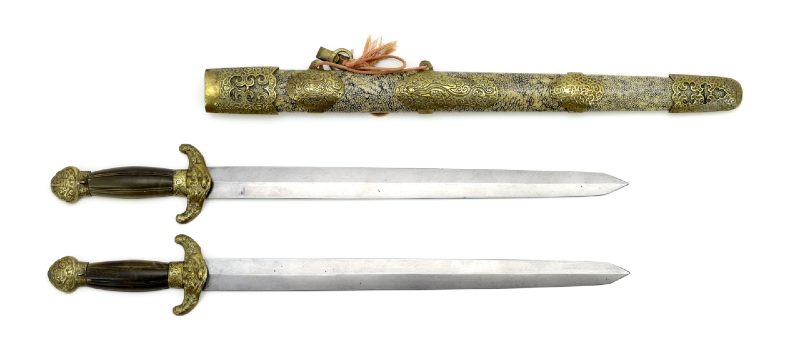
The shuang jian is a set of two jian swords that fit in a single sheath or scabbard. Most of them are short swords, usually with elaborate hilt designs. They became popular in the 18th century and served as good souvenirs for tourists. However, their quality also varied from well-made weapons to solely decorative pieces.
Tuanlian Jian (Militia Jian)
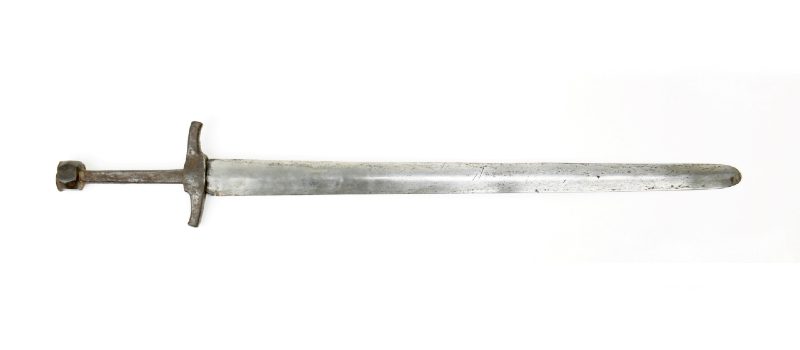
When the Chinese organized themselves in a militia called tuanlian, they also used jian swords to defend their villages. These swords had a simple appearance, thick and heavy blade, and iron mounts. Some of them had an overall length of more than 75 centimeters (29.5 inches) and blades of around 60 centimeters (23.6 inches).
Characteristics of the Jian Sword
Modern-day jian swords are similar to Qing dynasty designs, but their characteristics vary depending on the practitioner.
Blade Construction
In China, the steelmaking process involved utilizing a blast furnace to melt iron pieces, forming pig iron or cast iron. These materials are then further refined to produce wrought iron or, occasionally, steel of moderate quality. During the pre-Han period, some Chinese swords were crafted from cast iron, while others were made from low or medium-carbon steels.
Chinese swordsmiths used both hard and soft steels to create jian swords. Hard steel can be brittle, so it matters to produce a sword with a hard cutting edge that can withstand wear and tear.
Generally, a swordsmith could wrap the hard steel around a softer core of steel, or twist both hard and soft layers of steel before hammering them together. In some cases, the smith would first create a thin blade of hard steel, then sandwich it between soft steel cups for the length of the blade, resulting in a wide spine or face of the blade.
Regardless of the method, the blade would undergo a differential hardening process to strengthen the cutting edges without making the whole blade brittle. Generally, the blade is quenched or rapidly cooled by pouring water on the cutting edges.
Length of the Sword
The length of jian swords varied according to the stature of the practitioner. To get the ideal blade length, hold it in a reversed holding position or fanwo. Place your arm down along the side of your torso while the jian rests outside your arm, with its tip pointing up. The standard-length jian should be level with the top of the ear.
Historically, Northern Chinese were generally taller than Southerners and used relatively long and narrow blades. Their jian swords were usually 15 centimeters (5.9 inches) longer than their arm’s length. On the other hand, Southern Chinese used shorter swords, averaging arm length. However, the jian used in taijiquan, the tai chi sword, is generally longer than the Northern swords.
Weight and Balance
There is no standard weight for jian, but the Chinese swordsmiths produced well-balanced blades for battles. The proper weight allows the practitioner to perform several techniques without making extra effort to wield the sword.
Ideally, the center of balance should be no more than 10 centimeters up the blade from the handguard. However, heavier swords are well-suited to techniques that involve thrusting or chopping. Generally, some improve the sword balance by using a heavier pommel or even lengthening the handle.
Parts of the Chinese Jian Sword
Many special terms distinguish the parts of the jian sword. If you’re a sword enthusiast, here are the ones you need to be familiar with:
Blade (jianti)
The jian sword has a high-quality steel blade, usually about 66 to 91 centimeters long. Generally, it has three parts: the front edge, the middle edge, and the jian root.
The front edge or qianren starts from the tip, extending 6 inches downward. Warriors used this portion mainly for attacking since it is razor-sharp.
The middle edge of jian or zhongren is less sharp and thicker. It had varied uses like chopping, cutting, or diverting. The jian root refers to the 6-inch portion at the bottom of the blade. It was usually unsharpened and served as a defense against an opponent’s blade.
A jian blade has seven parts:
1. Edge (jianren)
The jian blade has a double edge, both sides identical. They are the sharpest and thinnest part of the blade. The upper edge is called shangren, and the lower edge is called xiaren. Regardless of the sword’s orientation, the shangren is on the same side of the thumb, while the xiaren is on the finger side of the hand holding the sword.
2. Tip of the Blade
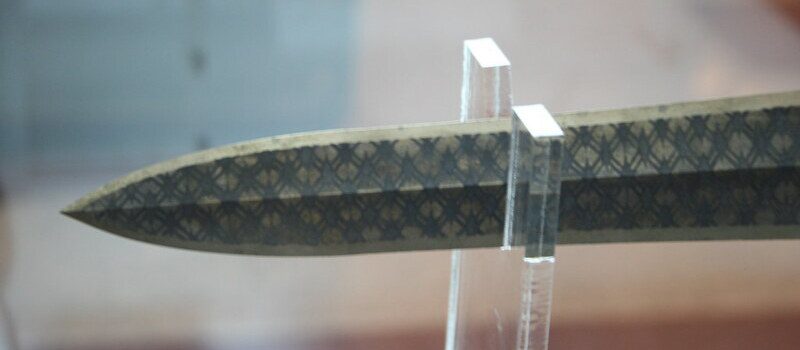
Battle-ready jian swords had a sharpened tip, unlike the jian swords used in dance performances and decoration. The term jian jian’er refers specifically to the tip, while jianfeng includes the top two inches of the blade and the tip.
3. Face of the Blade
Sometimes called jian mian, it is the face of the blade.
4. Ridge or Spine (jianji)
The jianji or jianbei is the convex part of the blade, though it will flatten out toward the tip.
5. Blood Groove or Fuller

The fuller runs most of the length of the blade, making it lighter without compromising its structural integrity. It is also called a blood groove due to the old belief that stabbing creates a suction effect on the blade, making the sword more difficult to withdraw.
6. Ricasso
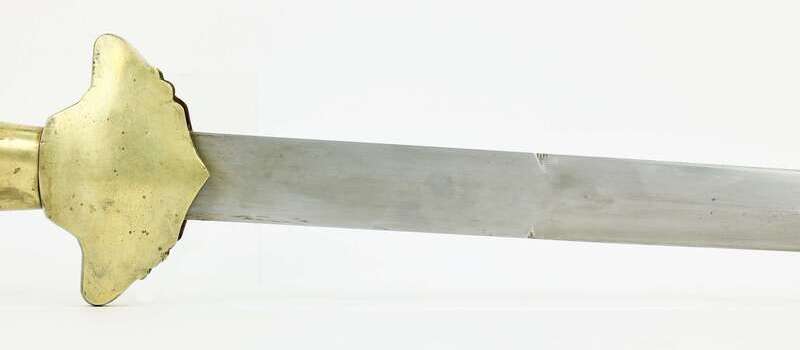
Some jian swords during the Qing dynasty featured a ricasso, which is the unsharpened part of the blade before the sword guard. It is likely a European influence and was typically used on heavier Chinese swords to allow a place to grip with the second hand if needed.
7. Tang
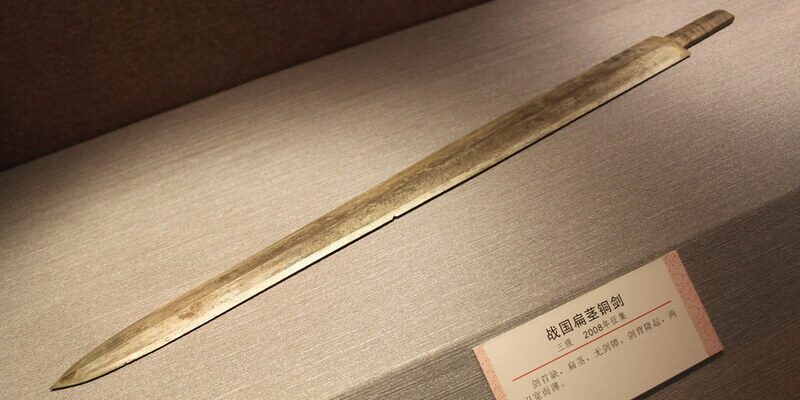
The tang is the unsharpened part of the blade covered by the hilt. Battle-ready swords have full tang blades, in which the tang extends beyond the handle through the pommel. The tang generally has the same width as the blade. However, most jian swords had relatively wide blades and narrow tang compared to straight swords of other cultures.
Hilt (jianba)
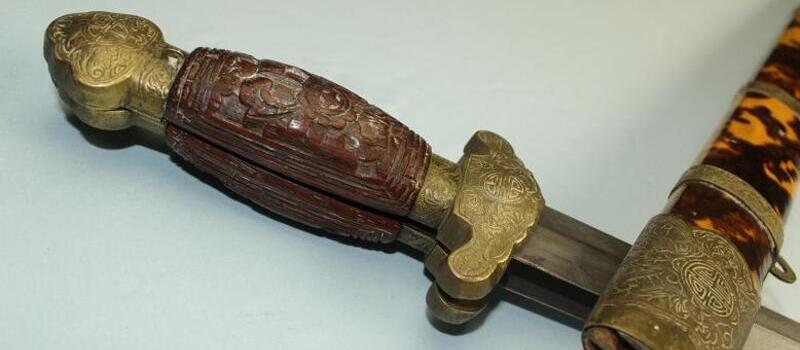
Also called jianjing or jianbing, the jianba is the handle of the jian sword. It is usually made of hardwood, wrapped in animal skin, and fastened to the tang. Other handles might also be plain or carved in varying lengths. Generally, jian hilt fittings are usually bronze or brass fittings and rarely German silver.
They are often engraved, studded with gems like jade, or feature gilt silver decorations. The hilt fittings consist of the handguard called hushou, which prevents an opponent’s sword from reaching the hand. It also features a pommel that serves as a counterweight to the steel blade and prevents the sword from sliding.
Tassel (jianpao)
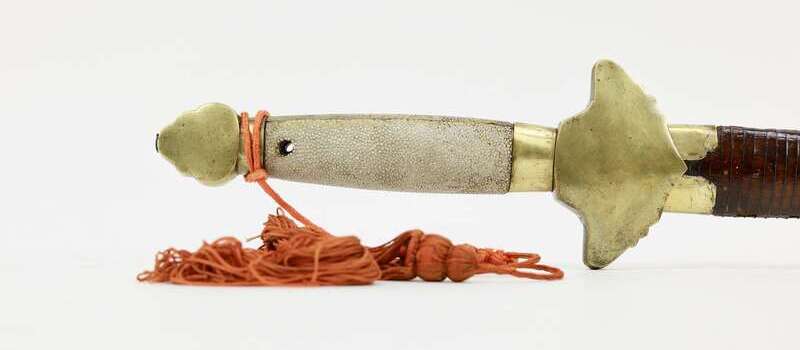
There are two kinds of tassel: the duansui, which is half the length of jian, and the changsui, which is as long as the
The wen jian, the straight
However, the wu jian, or martial arts
Scabbard (jianqiao)
Chinese swords usually had wooden scabbards, but metal scabbards doubled as a blocking weapon. Historically, the sheath of the jian included luxurious ornamentations to display the rank and wealth of the owner. Some designs featured dyed shagreen, stained stingray skin, or even colored lacquer. The sheath usually had bronze or brass fittings. Generally, a good sheath had a key that would eject the jian automatically.
The Jian in Chinese Martial Arts
The jian sword is used in different Chinese martial arts and sword systems and follows various principles, fighting applications, and sword training methods.
1. Taijiquan or Tai Chi
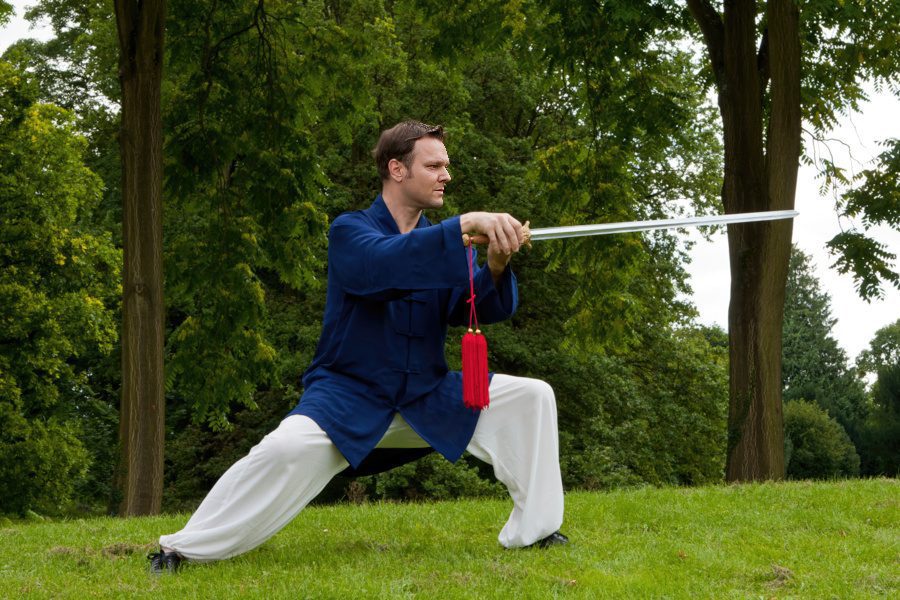
Also spelled taiji, taijiquan is a Chinese martial art that includes practice with weapons, including the straight sword jian. The sword practice incorporates principles from Chinese yin-yang, Daoist philosophy, and the five elements, along with martial techniques, meditation, and healing arts.
Unlike powerful chopping movements in other martial arts styles, the taiji jian sword form is characterized by minimal force, light movements, and refined skills. Taiji practitioners also train with the jian to counter various other weapons.
2. Wushu
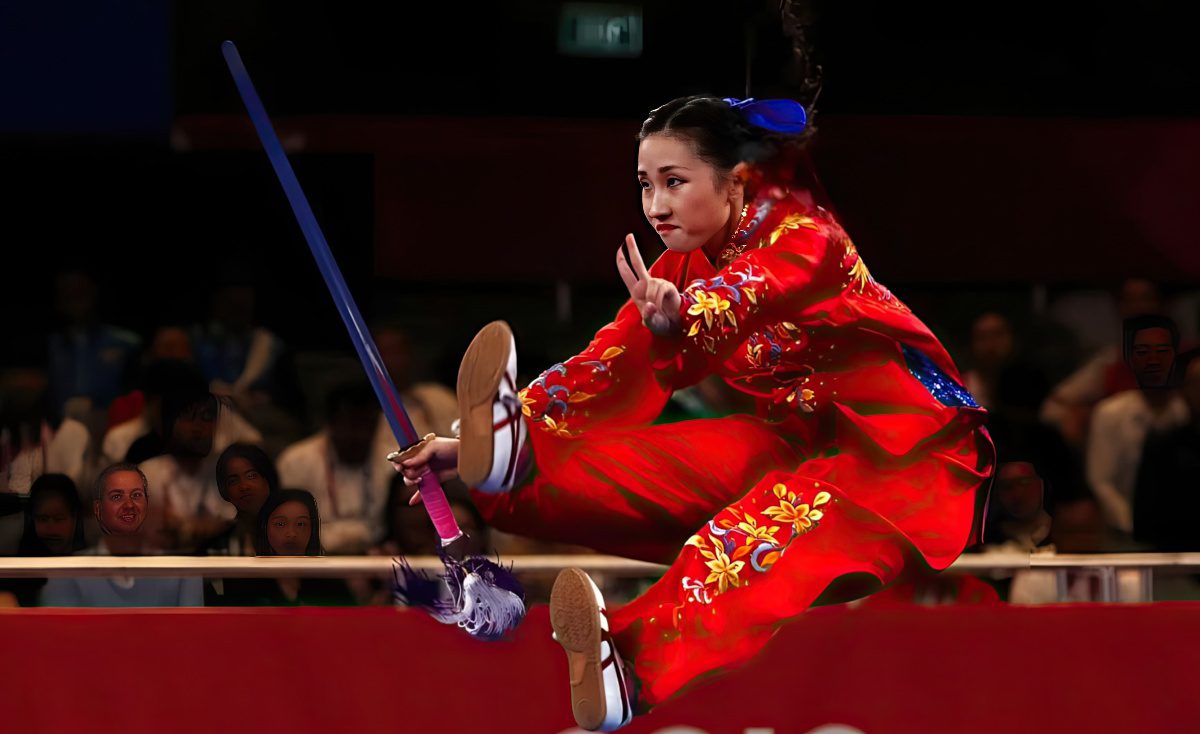
Wushu is a modern Chinese sport focusing on various skills and fighting techniques. The International Wushu Federation was founded to standardize many types of Chinese martial arts under the wushu category.
The jian is used in wushu performance-based sword arts, which consists of a series of choreographed movements. Wushu Jian performances showcase smooth transitions between stances and movements, thrusting techniques, intricate spins, jumps, and footwork.
3. Qingping Jian
The Qingping Jian was derived from ancient sword practice and is regarded as the last remaining Chinese sword system. It focuses on the straight sword jian, utilizing sword techniques that can be used for actual sword fighting. The movements of Qingping Jian are renowned for being light, quick, vigorous, and graceful.
Among the well-known sword routines, the Qingping Jian is the most extensive and has the most movements and techniques. Interestingly, there are 365 techniques, and by learning one technique a day, a practitioner would master the entirety of the system in a year. While many of its basic techniques are common to other well-known sword routines, they are unique in how they are executed.
The Qingping Jian consists of six straight sword routines that involve quick and unpredictable movements designed to outsmart the opponent rather than overpower them. The routines combine soft and hard movements, as well as fast and slow, creating diverse techniques for attacking, defending, countering, deceiving, trapping, and evading enemies.
4. Wudang Sword
Wudang martial arts, originating from Wudang Mountain in China, have various branches, some of which emphasize sword techniques. The Wudang Sword utilizes the straight sword jian. The Dan Pai lineage of the Wudang Sword originally focused on improvisation in sword combat.
The techniques of the Wudang sword contain the essence of the internal martial arts of Taijiquan, Bagua Zhang, and Xingyi Quan. Traditionally, an improvised solo practice form would utilize all the techniques in the system in a free-flowing manner.
5. Bagua Zhang
Also known as Eight Trigram Palm, the Bagua zhang is based on the ancient philosophy of Eight Combinations used in divination, consisting of three whole and broken lines. Some practitioners use the straight sword jian in training and walk in a circle while practicing certain moves.
6. Meihua Quan
Meihua Quan means Plum Flower Boxing, originating from Shaolin Boxing. It is a traditional martial art widely spread in North China and utilizes empty-hand techniques and weapons. The straight sword jian is among the typical weapons used in training. Meihua Quan became part of China’s Intangible Cultural Heritage, recognized by the State Council of the People’s Republic of China.
7. Xingyi Quan
Xingyi Quan is an ancient form of boxing in China, and the system is divided into Xing Quan (Form Boxing) and Yi Quan (Intention Boxing). The Xing Quan imitates the survival techniques of animals in how they use specialized parts of their body to beat the opponent.
On the other hand, the Yi Quan incorporates the ancient Chinese philosophy of Yin and Yang and the Five Elements, infusing them into boxing. The Xingyi Quan system includes various weapons forms, including the straight sword jian, the curved dao, and the spear.
History of the Chinese Jian Sword
The most popular types of Chinese swords are the double-edged, straight jian and the single-edged, slightly curved dao. In the West, the dao
Prehistoric China
Early jian swords had double-edged, straight blades but were made of copper. Many believe that they originated from the time of Huangdi, the Yellow Emperor, who started to rule in 2697 BCE. However, copper is a relatively soft metal, so these swords could not hold an edge and would break easily.
In Zhou Dynasty
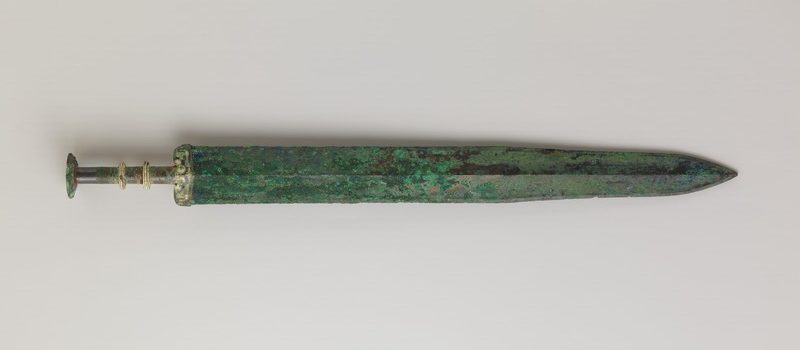
From 1046 to 256 BCE, bronze-made jian swords became popular. During the Spring and Autumn period from 770 to 476 BCE, China entered a time of turbulence, so the swordmaking of jian swords was highly developed. People carried them to show their high status, and the fighting principles of jian, still used today, were widely studied and practiced.
During the period, it had become known that when bronze, an alloy of copper and tin, consisted of higher amounts of tin, it became harder but also more brittle. Hence, the
In the Warring States period, from 475 to 221 BCE, many vassals competed for supremacy and used stronger, sharper swords. The metallurgy and metal-working techniques improved, which allowed the production of long jian swords with sharp edges. During this time, the amount of tin in the center of the blade is lower, giving tensile strength to the body, and higher at the edges, allowing sharpness.
In Qin Dynasty
Before the Qin dynasty emerged as a major power in China, it was the state of Qin, one of the many feudal states during the turbulent period. Qin armies used iron jian swords in defeating various states, so many people believed that their success was due to the iron
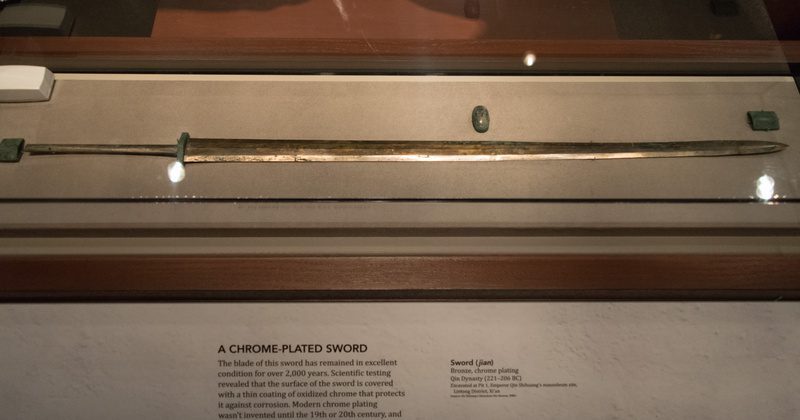
From 221 to 207 BCE, the Qin dynasty saw the perfection of bronze jian swords, as they became longer, narrower, and thinner. Jian swords of more than 100 centimeters in length were discovered in this period.
In Han Dynasty
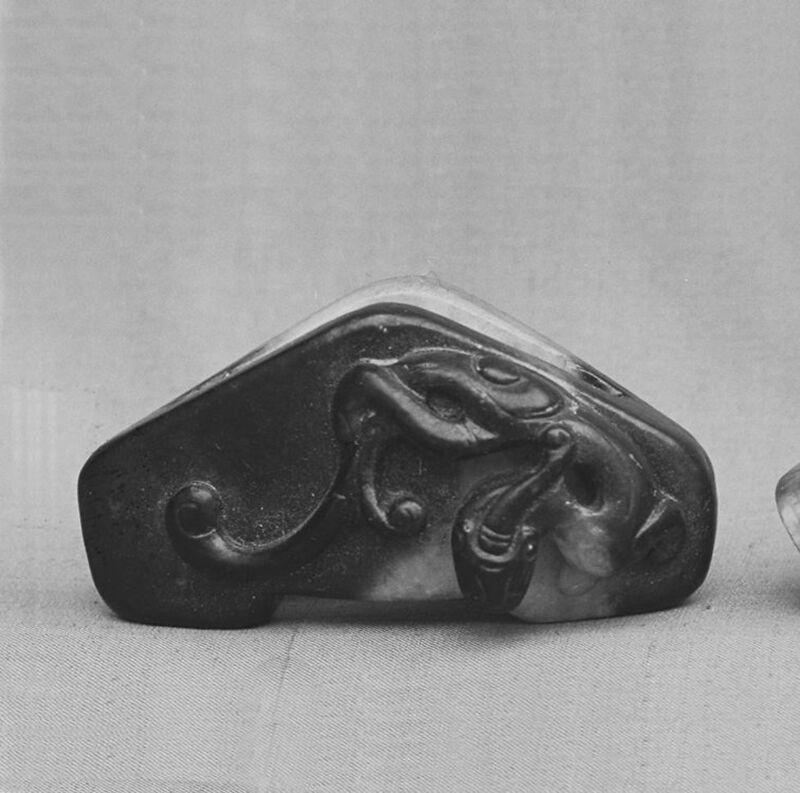
From 206 BCE to 220 CE, swordsmiths began making jian swords from steel, often with longer and narrower blades and featured jade carvings on the handle. The uses and significance of the straight
The type of jian indicated the rank and abilities of each government officer and played a role in official ceremonies and sacrificial religious rites. The Chinese even viewed the
In Tang Dynasty
From 618 to 907 CE, the steel jian
In Song Dynasty

From 960 to 1276, swordsmiths created Long Quan jian, also called Dragon Spring jian. The Chinese believed that these dragon swords could slice through ten large nails at a time. The Song dynasty ended with the Mongols conquering Chinese territory and founding the Yuan dynasty. This mixing of cultures influenced the
In Ming and Qing Dynasties
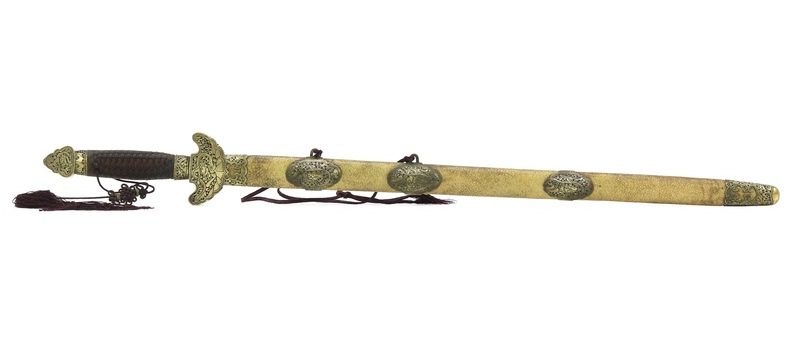
The Chinese conquered the Mongolian ruler and established the Ming dynasty. However, the Manchurians also invaded and formed the Qing dynasty. During these periods, swordsmiths used steel and other alloys to make swords, and Chinese martial arts developed to their highest level. Several martial arts groups used jian swords, similar to the ones used today.
Names of Jian Swords
The Chinese often gave their swords some names commonly indicating their owner, origin, or use. For example:
- Long Quan jian – Name for a
sword produced in Longquan County in Zhejiang Province.
- Kun Wu jian – A jian derived its name from the mountain where the ore used in making the
sword originated.
- Han jian – A jian
sword flourished in the Han dynasty from 206 BCE to 220 CE.
- Mo Xie or Gan Jiang jian – A jian
sword named after its swordsmith.
- Taiji jian or tai chi
sword – A straight, double-edgedsword used in taijiquan or tai chi martial arts.
Conclusion
The jian sword is one of the weapons that have been used and revered from the beginning of Chinese history to modern times. Chinese martial arts have their roots in traditional fighting techniques, and the jian sword remains significant in wushu and tai chi training.
